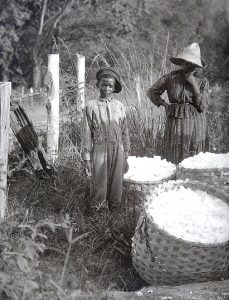This photograph was taken by Harry Hamilton Johnston in Tuskeegee, Alabama. It shows what is probably hundreds of cotton bales that were grown and collected by freed Blacks and are being prepared for transport to England. This image was taken in 1910, which was post-slavery, but Black people were still the main collectors of cotton through sharecropping. This image shows the significance of cotton during this period of time and how it transformed the nation.
After the abolition of slavery, some Black people chose to leave the South and seek better opportunities elsewhere. Black people all over the country faced significant challenges in finding employment and achieving economic stability. Many white people were unwilling to hire Black people, and those who did often paid unfair wages or subjected them to harsh working conditions. To address this issue, many Black people in the South turned to sharecropping((Shi, David Emory. America: A Narrative History. 12th ed., vol. 1, W.W. Norton and Company, 2021.)). Sharecropping was a system where a white landowner allowed a Black tenant to use the land in exchange for a share of the crop. It became a viable way for people to earn a living and support their families. However, sharecropping played into the hands of white landowners, who often set exorbitant rental rates and manipulated crop prices to their advantage. This left sharecroppers with little income and few options for improvement. Many sharecroppers were forced to take out loans from landowners to purchase supplies, which they were then required to repay with interest. This debt often became a trap because interest rates were so high that sharecroppers were unable to pay off their loans. Despite these challenges, sharecropping persisted as a way of life for many Black people in the post-slavery South((Shlomowitz, Ralph. “The Origins of Southern Sharecropping.” Agricultural History, vol. 53, no. 3, 1979, pp. 557–75. JSTOR, http://www.jstor.org/stable/3742755. Accessed 5 Apr. 2023.)).

After the abolition of slavery, cotton continued to be the major cash crop for Southern planters. The demand for cotton drove the economy of the region, and many planters turned to sharecropping to maintain their cotton production. One reason for cotton’s continued importance was the high demand for it in the textile industry. Despite advances in synthetic fibers, cotton remained a crucial component of textiles, and the demand for it only increased in the years following the Civil War. This demand ensured that cotton remained a profitable crop for planters, despite the challenges posed by the loss of their slave labor force. The continued demand for cotton and the development of new technologies and farming techniques allowed Southern planters to maintain their cotton production after slavery((Ferleger, Louis. “Sharecropping Contracts in the Late-Nineteenth-Century South.” Agricultural History, vol. 67, no. 3, 1993, pp. 31–46. JSTOR, http://www.jstor.org/stable/3744228. Accessed 5 Apr. 2023.)).

The first notable part of the image is the Black man who is carting bales of cotton via horsepower. It can be assumed that he is dropping the bales off from a crop that he worked on. On the right of the image, there are two Black people, a woman and a man. The woman has a child which suggests that she had no childcare and was forced to bring her child to work with her. In the top left corner of the image, there appear to be other Black people amongst the cotton bales, but it is unclear what they are doing. The different people in the image emphasize the fact that Black people, male and female, child and childless, had limited options of work besides sharecropping. While the continued collection of cotton by free Black people was a way of making a living, it was also a reminder of the continued economic and social inequality that persisted in the post-slavery South. Despite being legally free, Black people faced discrimination and violence, and their economic opportunities were limited by systemic racism and oppression. The resilience and determination of free Black people to make a living and assert their independence through cotton collection is a testament to their strength in the face of adversity((Span, Christopher M. “Post-Slavery? Post-Segregation? Post-Racial? A History of the Impact of Slavery, Segregation, and Racism on the Education of African Americans.” Teachers College Record: The Voice of Scholarship in Education, vol. 117, no. 14, 2015, pp. 53–74., https://doi.org/10.1177/016146811511701404.)).

